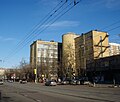Alexander Vasilyevich Kuznetsov
Alexander Vasilyevich Kuznetsov ( Russian Александр Васильевич Кузнецов ; born September 5 . Jul / 17th September 1874 greg. In St. Petersburg , † 2. January 1954 in Moscow ) was a Russian architect , entrepreneurs and university teachers .
Life
Kuznetsov studied at the St. Petersburg Institute for Civil Engineers with a degree in 1896 and then at the Royal Technical University of Berlin . He then worked in Moscow as an assistant to Lev Nikolajewitsch Kekuschew and from 1899 as an assistant to Fyodor Ossipowitsch Schechtels . Kuznetsov's first project was the Dormition Church of the Old Believers in Biala Kiernica (1900–1903). From 1905–1906, using an original design by William Walcot, he built the house of the Polytechnic Society on Moscow's Maly Charitonjewski Pereulok 6th.
From 1907 Kuznetsov taught as a professor at the Moscow Technical University , where he founded the architecture department (later the faculty ) together with Viktor Alexandrowitsch Wesnin . He developed his own architectural style between neoclassicism and expressionism using reinforced concrete , metal structures and glass blocks , which became known as reinforced concrete modernism . In 1908 he built the girls' high school and the new weaving factory in Bogorodsk . In Moscow on Roshdestvenka ulitsa, he built the workshop building of the Imperial Stroganov School for Art and Industry (now the Moscow Architecture Institute ) from 1912 to 1914 . In 1915 he bought an old villa (Manssurowski Pereulok 11, Moscow), which he then converted.
To build an automobile factory , Kuznetsov and the entrepreneur brothers Sergei , Vladimir and Stepan Pawlowitsch Ryabuschinski joined forces and opened the company Kuznetsov, Ryabuschinski , which was joined by entrepreneur Nikolai Alexandrovich Wtorov . In February 1916, the military technology headquarters commissioned Kuznetsov, Ryabushinsky & Co. to build an automobile factory and deliver 1,500 automobiles for a total of 27 million rubles . The factory should be completed no later than October 1916, and at least 150 automobiles should have been delivered by March 1917. The company was named AMO (Russian: Автомобильное московское общество, transliterated: Avtomobilnoje Moskowskoje Obschtschestwo, German: Moskauer Automobilgesellschaft). The Ryabushinsky brothers signed a license agreement with Fiat to build the Fiat 15 light military truck . The plant was built on the Tyufelewa Roschtscha in the south of Moscow under the direction of Kuznetsov and Artur Ferdinandowitsch Loleit . Konstantin Stepanowitsch Melnikow designed the building facades . The first director was Dmitri Dmitrievich Bondarev .
After the October Revolution in 1923, Kuznetsov was the chief designer of the First All-Russian Exhibition of Agriculture, Crafts and Industry . 1926–1928 he headed the construction of the Central Aerohydrodynamic Institute (ZAGI) at the Uliza Radio 24 in Moscow, the Moscow Energy Institute and the All-Russian Electrical Engineering Institute (Uliza Krassnokasarmennaja 12, Moscow) and the Moscow Textile Institute (Malaja Kaluschskaja Uliza). He taught at the architecture faculty of the WChUTEMAS . Ivan Sergejewitsch Nikolajew , Georgi Michailowitsch Orlow and Gennady Jakowlewitsch Mowtschan were among his students .
Honors
- Order of the Red Banner of Labor (1944)
- Order of the Great Patriotic War (1947)
- Medal "For heroic work in the Great Patriotic War 1941–1945"
Works
Individual evidence
- ↑ a b c d M. W. Naschtschokina : Архитекторы московского модерна. Творческие портреты . 3. Edition. Жираф, Moscow 2005, ISBN 5-89832-043-1 , p. 295 .
- ↑ Дом А.В. Кузнецова (accessed May 15, 2018).
- ↑ 99 Years of ZiL: From Car Plant to Potential New Hear of Moscow? In: / he Moscow Times . November 12, 2015 ( themoscowtimes.com [accessed May 6, 2018]).
- ↑ Соколов М .: АМО-Ф15, знакомый и незнакомый . In: Автомобильный моделизм . No. 6 , 2004, p. 17-20 .
- ↑ Реминский В. А .: Первый блин советского автопрома АМО Ф-15 . In: Наука и техника . No. 1 , 2006.
- ↑ SIL: Этапы становления: 1916–1923 (accessed on May 6, 2018).
- ↑ В. Э. Хазанова: Из истории советской архитектуры 1926–1932 гг .: Документы и материалы . Nauka , Moscow 1970, p. 57 .
| personal data | |
|---|---|
| SURNAME | Kuznetsov, Alexander Wassiljewitsch |
| ALTERNATIVE NAMES | Кузнецов, Александр Васильевич (Russian) |
| BRIEF DESCRIPTION | Russian architect, entrepreneur and university professor |
| DATE OF BIRTH | 17th September 1874 |
| PLACE OF BIRTH | St. Petersburg |
| DATE OF DEATH | 2nd January 1954 |
| Place of death | Moscow |









